干货丨利用“概念图”提升学生阅读技巧!全学段通用!
阅读提升技巧13:利用插图和图表辅助理解 #生活技巧# #自我提升技巧# #阅读提升技巧#
导语:阅读教学是课堂教学的重要组成部分。针对老师们在阅读教学中常见的“学生阅读思维能力难培养”这一问题,三好教师联盟本周再次推出关于在阅读教学中利用“概念图”的教学方法来提升学生逻辑思维与预测推理能力的实操方法,并以此提升写作技巧。文中详细阐述了此套方法的具体教学步骤,简单实用。
此实操方法适用于K12所有学段的阅读教学。为便于老师们应用,我们对原文内容做了重点步骤梳理,老师们可先阅读重点梳理内容再对最下方的英文原文进行阅读。实操部分可按照图例分步骤完成。
重点梳理
Using Concept Mapping to Teach Young EFL Learners Reading Skills
使用“概念图”提高二语学习者的阅读技能
BACKGROUND
课程背景
Concept mapping is related to the pedagogical theory of constructivism, which asserts that productive learning occurs when students create meaning on their own by connecting previous knowledge and experience with newly formed knowledge and experience.
“概念图”与结构主义的教学理论有关,该理论认为:高效学习发生在当学生将先前的知识和经验与新形成的知识和经验联系起来并自己创造意义的时候。
“概念图”的作用
1.帮助学习者理解主题框架;
2.让学习者明确所学内容之间的关联;
3.加强学习者的知识记忆能力;
4.提高老师的教学质量。
【注意】
在英语阅读教学中,老师应起辅助作用,帮助学习者将现有知识应用于新思想的同时,引导他们构建自己对于知识的理解,而不是单纯地被动吸收。
TWO CONCEPT-MAPPING LESSONS
两种“概念图”课程教学
The following two lessons are geared toward EFL learners with basic English language proficiency — at least two years of experience in learning English.
以下两个课程面向基本英语语言能力的二语学习者,要求学习者至少拥有两年英语学习经验。
【注意】
使用课程教学操作的老师需根据班级水平进行相应调整。
Concept-mapping Lesson One
第一种“概念图”课程教学
The objective of this lesson is to teach students to organize their ideas by drawing their own concept maps based on a story they are already familiar with.
教学目的
教会学生根据熟悉的故事绘制自己的“概念图”来整理思路。
教学设计
以通俗易懂的《冰雪奇缘》(Frozen)绘本为例而设计。
材料准备
绘本、电影、预制“概念图”(Pre-Made Chart for Frozen)、纸笔及一套彩色铅笔。
下方为绘本视频,老师们可供参考
↓
Procedure
实操过程
Step 1: Show the movie Frozen, which is dubbed in the students’ first language and contains English subtitles. Then, continue the lesson by showing the picture book of Frozen to the students and then ask individual students to narrate the story following the actual sequential order of the events.
播放《冰雪奇缘》电影,需有中英文双字幕。建议老师让学生多看几遍电影,然后进行讨论直至熟悉故事剧情。在课上展示《冰雪奇缘》绘本,抽几位学生按照事件顺序叙述故事。
Step 2: Introduce the idea of the concept map by showing the students the pre-made concept map in the Appendix.
向学生展示准备的“预制概念图”(Pre-Made Chart for Frozen),引入“概念图”概念。
1.介绍下图中的四大要素:Characters(角色)、Settings(环境)、Events(事件)、Time Order(时间顺序)。
2.老师解释每个类别的含义,以便学生了解要填写的内容。
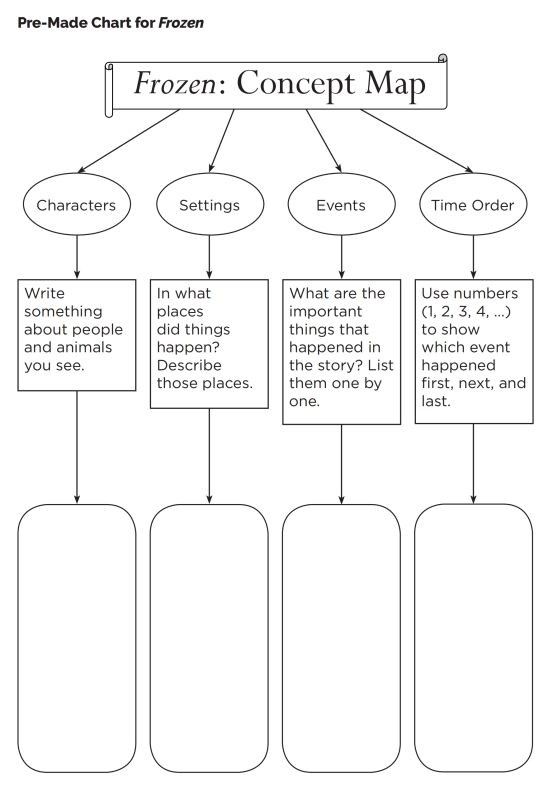
Step 3: Have students work in pairs to draw their own concept maps; encourage them to be creative.
让学生两人一组绘制自己的“概念图”,培养他们的创造力和自主性。
【示例】
学生在绘制自己的“概念图”时,不需要统一按照图示给出的画法,可以从绘本中选择自己喜欢的一个角色进行绘制。许多学生喜欢雪人Olaf这一角色,就按照雪人的形状绘制了“概念图”。如下图所示:
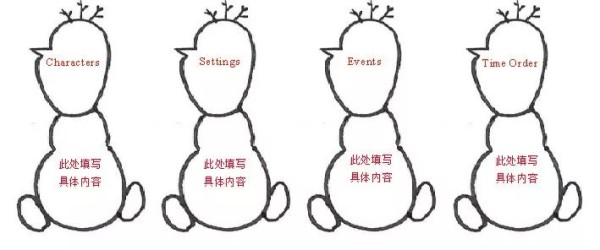
Step 4: Have the students rewrite their own versions of the story on their concept maps, adding any characters or events they create themselves.
让学生根据自己填写的“概念图”重新编写属于自己的故事,并添加自己创建的任何角色或事件。
【注意】
老师需强调在重编故事时学生要注意时间顺序和事件的逻辑顺序。
Step 5: This step serves as an assessment stage. Collect and record the ideas from Step 4 and invite students to share their opinions with the class about how they organized the events in the stories.
本步骤为测评阶段。收集并记录Step 4的故事,邀请学生在全班同学面前分享他们的故事及看法。
【注意】
若学生的故事不是按照时间顺序写的,帮助他们根据Step 4来理清故事的顺序。
Step 6: Give students time to work in pairs again to discuss the differences between others’ work and their own.
给学生时间让他们两人一组再次讨论各自作品的不同点。
【注意】
老师需指出事件是如何发展的,并在讨论过程中检查学生是否按照事件顺序进行写作。
Step 7: Ask each pair the following questions and give pairs opportunities to answer.
向每一组学生提出以下问题,并让他们进行回答。
Did you find any differences between others’ concept maps and your own?
Why did you make your concept map like this [Event A first, then Event B] instead of like this [Event B first, then Event A]?
Please explain why you wanted to present your story in this way.
【注意】
1.学生应通过口述的方式向全班或其他小组阐述某些事件为何发生在前或为何发生在后,这样做的目的是让学生证明故事中的时间顺序;
2.老师应通过本步骤评估学生写故事的逻辑顺序的能力。
【示例】
学生在阐释时会说:“In our story, at the beginning we put Johnny in the house instead of at school. The reason is that we wanted him to meet the stray dog on his way to school.”
Concept-mapping Lesson Two
第二种“概念图”课程教学
The objectives of this lesson are to promote students’ ability to use their vocabulary in various contexts and to make predictions and inferences using concept maps.
教学目的
提高学生在各种情境下使用词汇的能力,并利用“概念图”做出预测和推论。
教学设计
以绘本《糟糕,身上长条纹了!》(A Bad Case Of Stripes)为例而设计。
材料准备
铅笔、橡皮擦、白纸、预制“概念图”(如下图)
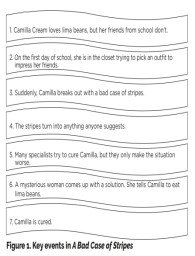
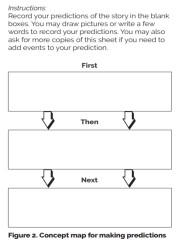
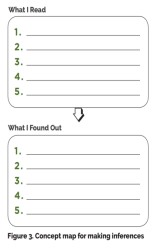
图1
图2
图3
下方为绘本视频,老师们可供参考
↓
Procedure
实操过程
Step 1: Explain to the students that in this lesson they will learn new vocabularies and reading skills for making predictions and inferences. Teach the vocabularies by using concept maps.
1.老师需要给学生说明本节课教学目的:学习新词汇和阅读技能,并对文章情节进行预测和推论。
2.使用“概念图”来教学生词汇。
【示例】
将单词“afraid”放在“概念图”中心的圆圈中,在周围画上四个正方形,并用线连接。然后让学生想象四个与恐惧相关的场景,绘制在每个正方形中。在绘制的图片旁写下与“afraid”相关的其他单词,以此让学生学会在不同情境下恰当地使用单词“afraid”。
Step 2: To encourage the students to make predictions, do not pass out copies of the storybook at this stage. Instead, read the first two pages of the story and then ask the class to predict how the story will continue. Do the same for several pages until the students are comfortable with making predictions.
为鼓励学生做预测,不要在此阶段分发整本故事书。相反,让学生阅读前两页后猜测故事将会发生什么,然后让学生阅读后面的章节,对比自己的猜测与原文的差异。多做几次这样的阅读和预测,直到学生适应做预测为止。
Step 3: Stop reading at a pre-selected page of the story and have students work with their partners and jot down their predictions for what remains. Students record their predictions on a concept map they create themselves or on one provided for them. (See Figure 2.)
让学生停止阅读预先选定的故事页,与小伙伴一起记下他们的预测。要求学生将自己的预测写在他们自己构建的或者老师提供的“概念图”上。(如图2)
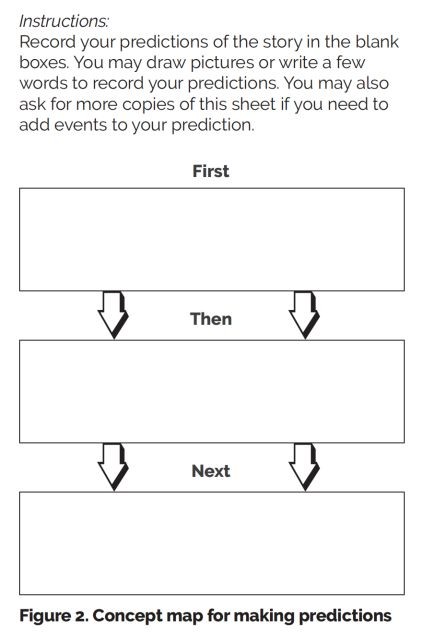
图2
Step 4: Give students copies of the story and ask them to read it silently on their own and at their own pace. Give students enough time to process and comprehend the story individually before they join their partners for further discussion.
向学生分发故事复印件,并要求他们默读。让学生在与小伙伴进一步讨论前,有足够时间来单独理解消化故事内容。
Step 5: Show the student pairs a chart created in advance to illustrate the chronological order of the events that take place in the book.
对学生展示预先制作好的图表(见图1)来说明书中发生事件的时间顺序。

图1
【注意】
1.老师应说明故事中没有事件数量的限制,学生可添加或删除列表中的事件;
2.老师需告知事件的总数不重要,重要的是他们的预测是否以时间顺序呈现。
Step 6: Invite the students to share their predictions and justify their answers with the class. In the meantime, the teacher assesses whether the students were able to make predictions effectively.
邀请学生分享他们的预测,并在课上验证预测。与此同时,老师评估学生是否能有效做出预测。
Step 7: Teach skills in making inferences. Explain that sometimes messages in a story are not told directly or explicitly to the readers. Ask students to fill out a generic concept map for making inferences (Figure 3).
教授学生推理技巧。要给学生讲清楚有时候故事中的信息不是直接或明确告知读者,但是可通过故事中的提示发现间接信息,然后要求学生填写推理的“概念图”(图3)。
【注意】
“概念图”由“What I Read”和“What I Found Out”两部分组成。

图3
Step 8: Demonstrate how to record information in the “What I Read” section by pointing out a few main ideas in the book.
通过分析故事中的主要内容,演示如何在“我读了什么”处填写信息。
【示例】
为了给学生演示这项活动,可写下一条主要内容,如:Loved lima beans…didn’t eat them.
然后问学生:Why didn’t Camilla eat lima beans even though she loved them?,接着让学生给出故事中隐藏的原因。
若学生回答:All of her friends hated lima beans.老师可回应:You are right. That reason is stated in the book. Can you guess why it matters to her whether her friends like or hate lima beans?
若学生回答:Because she wants her friends to like her.或She likes to please her friends.亦或者She wants to make more friends.老师可回应:Yes. Although the sentences on Page 1 do not tell us directly what you just said, your reason is probably right. It seems that Camilla didn’t want to do things her friends hated.
通过以上Q&A形式将学生的推论记录在“概念图”中“What I Found Out”部分。
Step 9: Ask the students to practice this activity in pairs. Each student takes notes and writes inferences on the concept map for making inferences and then, with partners, students explain what they wrote in each section.
让学生两人一组练习这项活动。每个学生在“概念图”上写下推论,再与小伙伴解释每个部分所写内容。
Step 10: In Step 8, examples were given to demonstrate how to record on the “What I Read” and “What I Found Out” sections. Step 10 provides more opportunities for practices by sharing the student-generated examples with the class.
在Step 8中,举例说明如何填写“What I Read”和“What I Found Out”这两个部分。本步骤则给学生更多实践机会,与全班分享他们自己的例子。
【示例】
当学生在“What I Read”写道:Camilla loves lima beans, but she never ate them because her friends hate lima beans.,老师可鼓励学生解释Camilla是什么样的人。
作者在文中并未直接告知Camilla是什么类型的人。学生在此处可猜测:She might be shy or be unfriendly.亦或者是其他想法。老师应鼓励学生从细节处出发来进行猜测,并记录在“What I Found Out”。
通过以上示例,让学生多多进行练习,直至其能独立完成图3的绘制。
Step 11: Assess the students’ reading comprehension and skills in making inferences by asking two open-ended inferential questions based on the story.
老师可以根据故事内容提出两个开放式推理问题,评估学生的阅读理解和推理能力。
Why is Camilla so eager to fit in with her classmates?
Do you think Camilla’s classmates are her true friends? Why or why not?
ADAPTING CONCEPT-MAPPING LESSONS
改编“概念图”课程
Throughout the process, it is important for the teacher to make necessary adjustments to the activities based on each student’s unique learning needs, language proficiency level, and progress.
在整个过程中,老师需根据每个学生独特的学习需求、语言水平和进度对活动进行必要的调整。
【示例】
如果学生在填写“概念图”时,不能拼写某些单词或无法用句子表达自己的想法,则可允许他们用绘图来表达。如果学生因缺乏语言水平而无法写出完整句子,那么让其填写关键词或短语。
Concept maps are an effective teaching tool, and the ones included in this article can be adapted for many types of reading lessons.
“概念图”是一种有效的教学工具,文中包含的内容可适用于许多类型的阅读课程。
【示例】
老师可通过以下问题和任务让学生绘制“概念图”:
What are some of the main ideas in the story? Please create concept maps to express your ideas.
What are the details that support each main idea in the story? Please create concept maps to express your ideas.
【注意】
老师在为学生选择故事时应注意:
1.Have a clear chronological order to help students follow the storylines without getting confused.
故事需具有明确的时间顺序,以此帮助学生不会混淆故事情节。
2.Have easy-tounderstand plots so that the students can find the important characters, settings, and events from the stories and record them on the concept maps.
具有易于理解的情节,以便学生可以从故事中找到重要的人物、环境和事件,并记录在“概念图”上。
3.Allow students to relate the stories to their daily experiences.
故事应可与学生的日常生活联系起来。
CONCLUSION
总结
When we taught the two lessons described in this article, we observed our young readers learn to visualize their thoughts and organize their ideas by using concept maps we created for them and those they developed on their own. Through out the activities, they reinforced knowledge they had learned previously and discovered links between ideas. In the process, they also showed their confidence and competence in making predictions and inferences.
当我们在阅读课运用文中提到的两种教学方法时,可以明显看到通过使用“概念图”学生能够更好地组织他们的想法,并将其形象化,让学生在巩固已学知识的同时,找到他们思维的内在联系,展示出自己的预测和推理能力。
网址:干货丨利用“概念图”提升学生阅读技巧!全学段通用! https://www.yuejiaxmz.com/news/view/1062754
相关内容
英语阅读提升技巧初中生英语阅读理解技巧提升
巧用“群文”阅读提升学生的习作能力
高效学习英语技巧:利用小红书提升阅读与写作能力
提升学习效率的10大阅读技巧,让你事半功倍
小学阅读理解技巧的进一步提高.pptx
学生个人阅读的技巧.doc
提高现在文学阅读能力的技巧
学会这10个技巧 阅读理解能力大提升
小学生语文阅读能力提升的方法归纳总结大全

